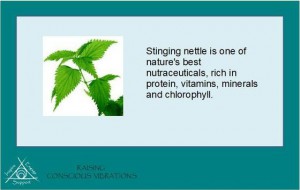
Also known as stinging nettles these are one of nature’s best nutraceuticals. Rich in protein, minerals (especially silica and calcium), iron, vitamin A, C, & K, as well as chlorophyll nettles are power houses for us and our animals. They can be boiled, steamed or sauteed, substituted for spinach in any recipe, or added to soups and stews. After rubbing the leaves and stems between two layers of cloth to remove the stinging hairs they can be added to salads. And they make an awesome pesto.
From a medicinal standpoint nettles have traditionally been used for a wide range of ailments such as chronic headaches, sore throats, sinus infections, anemia, poor circulation, gout, bronchitis, asthma, hives, hay fever, kidney stones, urinary tract infections, premenstrual syndrome, sciatica and multiple sclerosis. They are used to assist coagulation, help with the formation of hemoglobin, strengthen lungs, hair, nails and connective tissue, inhibit adrenaline and increase urine flow by acting as a natural diuretic. Nettles also boost liver and heart health. Used as a mouth rinse nettle tea is used to prevent dental plaque and gingivitis. Nettle root is also believed to be effective in treating an enlarged prostate especially at early onset.
Nettles can be used dried, in a tea, a tincture, or a poultice. Harvest the leaves in early-mid spring before the flowers form. The early leaves (before the plant is knee high) are the tastiest.
Nettles are safe for pets for the same ailments and can be dried and sprinkled over their food (~½ tsp per 500g of food for dogs and 1/3 tsp per meal for cats), or cooked in water until soft and tender and fed on their own or added to food. They can also be given as a tea or tincture and as for humans used as a poultice. Nettles are perfect for any animal that needs a small amount of trace minerals and vitamins. They can be used in a skin and coat rinse that nourishes the animal’s fur and provides relief from itchy skin and bites.
Stinging nettle reminds us to be mindful. We can easily miss seeing nettles when they appear in spring time however a simple brush against the plant with our bare skin and the sting reminds us to be aware of our surroundings and to be in the now. It also teaches us to take a fresh look at what is around us and learn to appreciate and work with what we have been blessed with. We can reap so many beautiful, healing benefits from stinging nettles, we just need to look at them, not as a weed or something to dread, but as something to be careful and respectful with.
Remember to always wear gloves and long sleeves when harvesting nettles. They have nearly invisible stinging hairs on the stems and leaves each of which contains a droplet of formic acid. When you brush against the plant the hair tip pierces your skin and the formic acid is injected causing itching and a burning sensation which may last for a few minutes or even up to a couple of days. Cooking or drying neutralizes the stinging hairs. As with all plant harvesting, for the highest vibration make sure you harvest away from conventional farms or other places using chemical fertilizers, pesticides and herbicides.
For those in the northern hemisphere, gather your stinging nettles now and enjoy the wonderful health benefits of them fresh or dry them for the winter months. For those in the southern hemisphere, store this knowledge away for now and remember to look out for the shoots when spring comes around again!
